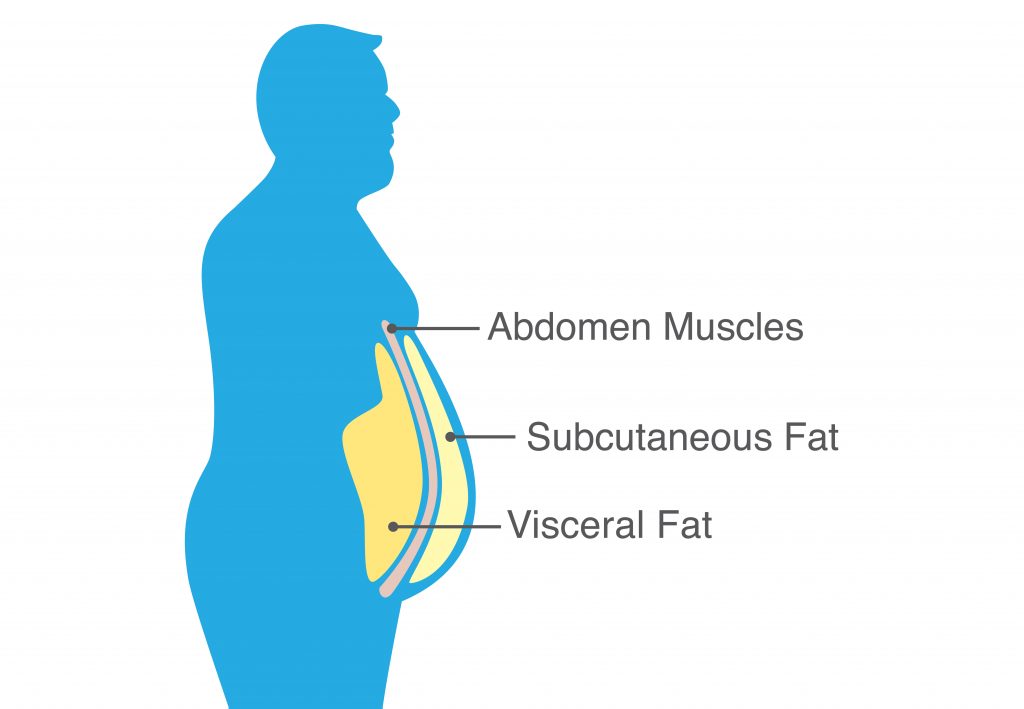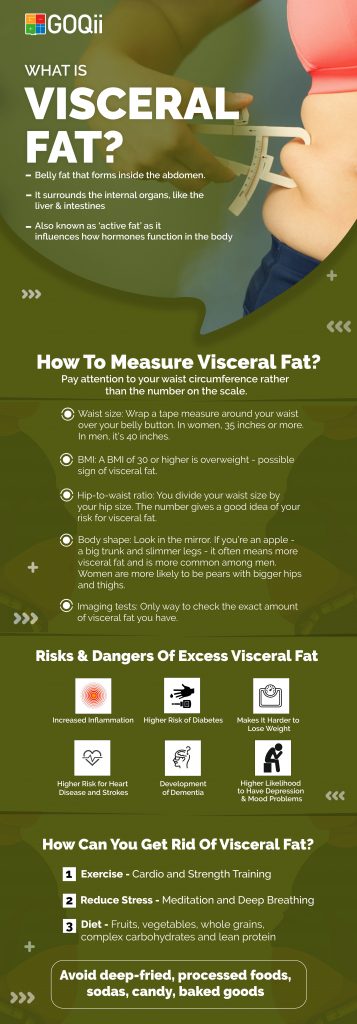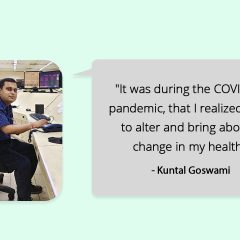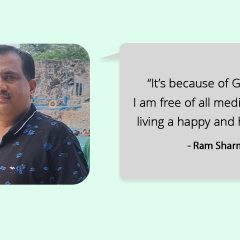
You might have heard of the term belly fat but you might not be aware of terms like subcutaneous and visceral fat. Subcutaneous fat is the kind you can grasp with your hand on any part of your body. It is situated under the skin. Belly fat or what experts call visceral fat is a particularly dangerous type of fat that forms inside the abdomen. It’s a type of fat that surrounds the internal organs, like the liver and intestines and is also known as ‘active fat’ as it influences how hormones function in the body.
You can have too much belly fat even with a normal BMI. So pay attention to your waist circumference rather than the number on the scale.
How To Measure It
- Waist size: This is an easy way to get a rough estimate. Wrap a tape measure around your waist over your belly button (don’t suck in your stomach). In women, 35 inches or more is a sign of visceral fat. In men, it’s 40 inches.
- BMI: Body mass index is a formula for how much you weigh relative to your height. A BMI of 30 or higher is overweight. That could be a sign of visceral fat. In Asia, a BMI of 23 or higher could be a concern.
- Hip-to-waist ratio: You divide your waist size by your hip size. Some doctors think the number gives a good idea of your risk for visceral fat. But studies suggest it may be no better than a simple waist measurement.
- Body shape: Look in the mirror. If you’re an apple – a big trunk and slimmer legs – it often means more visceral fat and is more common among men. Women are more likely to be pears with bigger hips and thighs. Research shows that upper body fat is more dangerous to your health, which might be one reason why women usually live longer than men.
- Imaging tests: These scans are the only way to check the exact amount of visceral fat you have. If your doctor orders a CT scan or an MRI test to check for another medical condition, they can also get a detailed picture of your visceral fat.
Risks & Dangers Of Excess Visceral Fat
- Increased Inflammation: If you have more fat stored than you need, especially around visceral organs like the liver, heart, kidneys, pancreas and intestines, your body becomes inflamed. This kind of fat stores inflammatory white blood cells and this is why inflammatory belly fat is linked with cognitive decline, arthritis, diabetes and so on.
- Higher Risk of Diabetes: Visceral fat is thought to play a large role in insulin resistance, which means a heightened risk for developing diabetes. Abdominal fat is viewed as a bigger health risk than hip or thigh fat, not only for diabetes but for many other chronic diseases too. Some evidence suggests that pear-shaped women are better protected from metabolic diseases like diabetes compared to big-bellied people. While men are more likely to store noticeable levels of visceral fat, women are definitely at risk, too.
- Makes It Harder to Lose Weight: One of the main reasons is that stored body fat affects hunger levels, especially visceral fat. Leptin hormone which is released by stored fat plays an important role in appetite control, metabolism and weight loss. Leptin is a satiety hormone and ghrelin is a hunger hormone are two of the most hormones to pay attention to in reference to losing weight naturally. Your “set point” is basically the weight that your body tries to maintain through control of the brain’s hormonal messengers. When you eat refined carbohydrates such as white flour and sugar, the fat-storing hormones are produced in excess, raising the set point and making it hard to follow a moderate-calorie, healthy diet.
- Higher Risk for Heart Disease and Strokes: Fat-generated inflammatory cytokines are the main contributors to heart disease and other inflammatory disorders. When your body is inflamed, your liver becomes overwhelmed with cholesterol and toxins, which leads to plaque buildup in your arteries. Visceral fat is associated with an increased risk for cardiovascular disease markers like high triglycerides, high blood pressure and high cholesterol.
- More Likely to Battle Dementia: Research shows that people with the biggest bellies have a higher risk of dementia than those with smaller bellies. The bigger the belly, the more negative impact felt on the brain’s memory . In fact, many experts now feel that visceral adipose tissue (VAT) levels rather than BMI should be considered as an important risk factor in the development of dementia.
- Higher Likelihood to Have Depression and Mood Problems: Visceral fat is a unique pathogenic fat that consists of metabolically active adipose tissue that interferes with the hormones and healthy neurotransmitter function. Depression is especially associated with greater fat storage in women. In a study of middle-aged women over 50 years old, visceral fat, but not subcutaneous belly fat or waist circumference, was related to depressive symptoms.
How Can You Get Rid Of It?
- Exercise: is an excellent way to reduce visceral fat. People should include both cardio vascular exercise, which raises a person’s heart rate and strength training, which improves muscle size, into their routines. Cardio exercise could include running, cycling, swimming, aerobics, circuit training. Strength training could include squats, weights, pushups.
- Reduce Stress: When someone is stressed, their body releases a cortisol hormone, which increases how much visceral fat a person’s body stores. People with high visceral fat try to reduce their stress levels by relaxation techniques, such as meditation, deep breathing, and other stress management tactics, can help a person lose visceral fat more efficiently.
- Diet: A healthy diet should include fruit and vegetables, whole grains like quinoa, millets and oatmeal, and lean protein like skinless chicken, fish, eggs, beans, complex carbohydrates such as sweet potatoes, beans. Studies suggest that more Calcium and Vitamin D in your body may be linked to less visceral fat. So load up on leafy greens like collards, spinach, tofu and sardines are also good picks, as are low-fat dairy foods like yogurt, cheese, and milk.
Boiling, steaming, baking, and grilling foods will help to make meals healthier and lower in fat. On the other hand, certain foods encourage belly fat like trans fats are found in meats and dairy as well as in deep-fried or processed foods. Also avoid sodas, candy, baked goods, and other foods sweetened with fructose. This is why it’s important to kick your sugar addiction and address weight gain and visceral fat formation early on, as opposed to letting the situation escalate. So, read labels and avoid ingredients like “partially hydrogenated oils” or “high-fructose corn syrup”.
We hope this article helps you! If you are keen on losing weight in a healthy, sustainable way, you can reach out to an expert by subscribing for Personalised Health Coaching here.
For more articles on weight loss, check out Healthy Reads.
#BeTheForce




